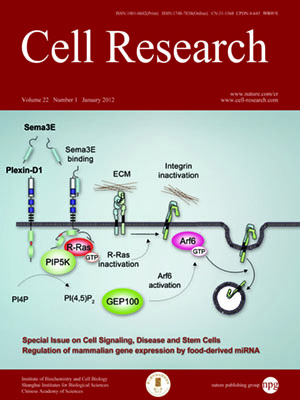
Volume 22, No 1, Jan 2012
ISSN: 1001-0602
EISSN: 1748-7838 2018
impact factor 17.848*
(Clarivate Analytics, 2019)
Volume 22 Issue 1, January 2012: 127-141
ORIGINAL ARTICLES
Caspase cleavage of cytochrome c1 disrupts mitochondrial function and enhances cytochrome c release
Yushan Zhu1,2,*, Min Li3,*, Xiaohui Wang1, Haijing Jin1, Shusen Liu11, Jianxin Xu3 and Quan Chen1,2
1The Joint Laboratory of Apoptosis and Cancer Biology, The National Key Laboratory of Biomembrane and Membrane Biotechnology, Chinese Academy of Sciences, Beijing 100101, China
2College of Life Sciences, Nankai University, Tianjin 300071, China
3Institute of Biophysics, Chinese Academy of Sciences, Beijing 100101, China
Correspondence: Quan Chen, Jianxin Xu,(chenquan@nankai.edu.cn; xujx@sun5.ibp.ac.cn)
Mitochondrial catastrophe can be the cause or consequence of apoptosis and is associated with a number of pathophysiological conditions. The exact relationship between mitochondrial catastrophe and caspase activation is not completely understood. Here we addressed the underlying mechanism, explaining how activated caspase could feedback to attack mitochondria to amplify further cytochrome c (cyto.c) release. We discovered that cytochrome c1 (cyto.c1) in the bc1 complex of the mitochondrial respiration chain was a novel substrate of caspase 3 (casp.3). We found that cyto.c1 was cleaved at the site of D106, which is critical for binding with cyto.c, following apoptotic stresses or targeted expression of casp.3 into the mitochondrial intermembrane space. We demonstrated that this cleavage was closely linked with further cyto.c release and mitochondrial catastrophe. These mitochondrial events could be effectively blocked by expressing non-cleavable cyto.c1 (D106A) or by caspase inhibitor z-VAD-fmk. Our results demonstrate that the cleavage of cyto.c1 represents a critical step for the feedback amplification of cyto.c release by caspases and subsequent mitochondrial catastrophe.
Cell Research (2012) 22:127-141. doi:10.1038/cr.2011.82; published online 17 May 2011
FULL TEXT | PDF
Browse 2274


